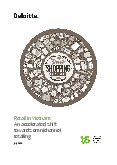



















Preview text:
Global Powers of Retailing 2021 Contents Top 250 quick statistics 4 Global economic outlook 5 Top 10 highlights 8
Impact of COVID-19 on leading global retailers 13
Global Powers of Retailing Top 250 17 Geographic analysis 25 Product sector analysis 32 New entrants 36 Fastest 50 38
Study methodology and data sources 43 Endnotes 47 Contacts 49 Acknowledgments 49
Welcome to the 24th edition of Global Powers of
Retailing. The report identifies the 250 largest retailers
around the world based on publicly available data for
FY2019 (fiscal years ended through 30 June 2020), and
analyzes their performance across geographies and
product sectors. It also provides a global economic
outlook, looks at the 50 fastest-growing retailers, and
highlights new entrants to the Top 250.
Top 250 quick statistics, FY2019 US$4.85 US$19.4 Minimum retail revenue required to be trillion billion among Top 250 Aggregate Average size US$4.0 retail revenue of Top 250 of Top 250 (retail revenue) billion 4.4% 5-year retail Composite revenue growth net profit margin 4.3% Composite (CAGR Composite year-over-year retail FY2014-2019) 3.1% return on assets revenue growth 5.0% Top 250 22.2% 11.1 retailers with foreign operations Share of Top 250 Average number aggregate retail revenue of countries where 64.8% from foreign companies have operations retail operations
Source: Deloitte Touche Tohmatsu Limited. Global Powers of Retailing 2021. Analysis of financial performance and operations for fiscal years ended through
30 June 2020 using company annual reports, press releases, Supermarket News, Forbes America’s largest private companies and other sources. 4
Global Powers of Retailing 2021 | Global economic outlook Global economic outlook
In the early months of 2021, the world was faced with both promise and peril. On the positive
side, the distribution of vaccines for COVID-19 was under way, offering the promise that,
sometime later in the year, the negative impact of the virus could abate significantly. On the
negative side, the virus continued to threaten economic stability, especial y in those parts of the
world where it was still prevalent and threatened to be a problem elsewhere if new and virulent
strains of the virus were spread widely. Even in places where the outbreak was limited, there was
a negative economic impact from social distancing measures to avoid a further outbreak. The
chal enge for policymakers was to control the current outbreak, protect those who have been
disrupted by it, and speed up the distribution of approved vaccines. The speed and success of
these three imperatives will determine the path of the global economy in the year ahead.
The comments in this article were current at the time of writing
consumer spending found that, starting in early January, spending
(April 2021) and developments and policies may have changed
accelerated—especially among lower income households. This since then.
could be explained by growing confidence that the worse is over,
the renewal of government stimulus in late December, and the
For many (but not al ) retailers, the pandemic has been a perfect
expectation of more stimulus to come.
storm. Not only have many of them been adversely affected by the
suppressed economic activity, they have also had to contend with
In December 2020, the US Congress passed and the president
a decline in consumer mobility, an increase in online activity, and
signed a spending package of about US$900 billion.4 This included
reduced spending on discretionary products, such as clothing.
extended unemployment insurance, cash for households and
On the other hand, grocery retailers have benefitted from the
businesses, and money for education and medical care. It gave a
closure of restaurants and online retailers have benefitted from
modest boost to the economy for a few months. In March 2021,
consumers’ aversion to in-store shopping. These changes in
the Congress passed President Biden’s proposed US$1.9 tril ion
behavior have been disruptive to traditional supply chains. Going
stimulus that provided US$1,400 to 85% of Americans, extended
forward, economic activity and consumer demand will eventual y
unemployment insurance, assisted state and local governments,
recover, but how and where people shop may not return to pre-
and accelerated vaccine distribution. This plan is expected to
pandemic patterns, leaving many store-based retailers facing a
boost growth in 2021. There is a debate, however, as to whether it
significant and permanent loss of business.
wil cause the economy to overheat, thereby fueling much higher inflation. United States
The US economy weakened toward the end of 2020. Official
Much of the disruption to the US economy came from weak
figures for personal income and consumer spending both
consumer spending on services such as restaurants, airlines,
declined1 in November, employment and retail sales declined in
hotels, and retail stores—which all involve some degree of social
December, and some measures of housing activity2 weakened
interaction and a risk of infection. On the other hand, some parts
after many months of stellar performance. Although the rate
of the economy performed wel , like spending on durable goods
of new infections began to fal toward the end of December,3
such as automobiles and digital goods, as wel as activity in the
an increase in holiday travel in late December combined with
housing market. In retailing, the decline in in-store shopping
new strains of the virus resulted in another surge in infections
was offset partial y by a sharp rise in online shopping. This was
in early January, although by February and March this was
consistent with other aspects of life that involved more online
abating. Moreover, there were indications as the year began that
interaction such as working from home, being entertained from
economic activity was picking up speed. High frequency data on home, and learning from home. 5
Global Powers of Retailing 2021 | Global economic outlook
Eventual y, the virus wil be suppressed sufficiently to al ow
Many European countries have chosen to extend economic
a return to a pre-pandemic level of economic activity. When
restrictions until April 2021 and possibly beyond. In the United
recovery comes, we can expect that middle-to-upper income
Kingdom, the government has imposed stricter limits on
households will stop saving such a large share of their income
economic activity compared to other countries (note that the
and instead spend more on consumer-facing services such as
United Kingdom is made up of four devolved nations, each
restaurants and travel. This shift in behavior will go a long way
of them with power over their own policies for dealing with
toward boosting the rate of economic growth. It could also
COVID-19, including when to ease restrictions). In France,
create a temporary rise in the rate of inflation if it leads to supply
the government is extending lockdowns geographically and
bottlenecks. Disruption of the job market will be a longer-term
postponing the removal of existing restrictions. These and
problem: even a robust recovery later this year is unlikely to ease
other measures are likely to cause the rate of economic growth
unemployment among many former employees of consumer-
to decelerate or be negative in the first quarter. Moreover,
facing industries. There will be plenty of talk about a so-called
the fear is that the situation will remain precarious until much
K-shaped recovery, which is likely already under way, in which
larger numbers of people are vaccinated. Yet the number of
there is growing income inequality, with less educated workers
vaccinations administered in the European Union (EU) is far
facing financial stress and unemployment while more educated
below initial plans, and with ongoing vaccine supply problems,
workers retain their jobs and income and increase their wealth.
the outlook in the region is uncertain. Even so, the EU has made
a fairly optimistic forecast for economic growth in the bloc
In the post-COVID era, it is likely that some of the structural
beyond the first quarter of 2021. This forecast assumes early
shifts in the US economy that occurred in 2020 will endure.
suppression of the virus outbreak, a removal of restrictions,
These might include more working from home and a consequent
accelerated distribution of vaccines, and continued fiscal support
decline in demand for office space; more shopping from home for households and businesses.
and a consequent decline in the number of store-based retailers;
and more home entertainment and a consequent increase in
In Europe, the United Kingdom has been the most successful in
streaming and gaming services. There is also likely to be a shifting
the distribution of vaccines. At the same time, it has also seen
emphasis in the redesign of supply chains—rather than focusing
the worst economic performance owing to stringent economic
only on speed and cost, global companies wil also build on
restrictions, although the outlook, is looking promising for later
resilience, redundancy, and diversification. This might result in
in 2021 once the vaccine program nears completion. On the
less exposure to China and greater exposure to Southeast Asia or
other hand, the United Kingdom has exited the EU and although Latin America.
there is a free trade agreement, there are also new rules and
restrictions on the movement of goods across borders as well Europe
as restrictions relating to services trade. The resulting disruption
A second surge of the coronavirus started in Western Europe in
may have a negative impact on growth for both the United
October 2020, leading governments to impose new lockdown Kingdom and the EU.
restrictions and setting the stage for a sharp decline in economic
activity in the fourth quarter. As the quarter unfolded, the surge
The shift toward online retailing in Europe has been important
reversed, with the number of new infections fal ing sharply
but not as much as in the United States and China, and economic
in several European countries as people stayed home and
recovery is therefore more dependent on a return of consumer
complied with government restrictions on social interaction.
confidence in visiting physical stores on the high street.
The forecast for economic recovery is uncertain. A new strain of
the virus (known as the UK or Kent variant), which first ravaged China
the United Kingdom, later spread to other countries, especial y
China’s economic growth continues at a healthy pace. Consumer
across Europe and the surge in the virus has put greater stress
spending has been boosted by confidence that the virus is under
on national health systems. Other new and more virulent strains
control. Fixed asset investment has been helped by substantial
of the virus (e.g., South Africa and Brazil variants) threaten to
funding by state-owned banks for state-owned enterprises,
undermine the positive impact of vaccines and cause further
as well as regional governments that are investing heavily in
waves of infections, because of their greater contagiousness and
infrastructure. And exports have performed wel , in part owing
apparent resistance to some vaccines. This could have negative
to China’s global competitiveness in technologies for which
economic consequences, especial y if European governments
demand has increased during the pandemic. However, there
continue with lockdown measures to enforce social distancing.
is evidence that, while strong, the rate of growth in economic
activity is decelerating. This might reflect weakness in key export
markets such as the United States and Europe. There may also be
some concern about some local outbreaks of the virus that have
required new economic restrictions. 6
Global Powers of Retailing 2021 | Global economic outlook
The relative strength of China’s economy has come with a cost Emerging markets
in terms of rising debt. The government appears keen to avoid
There has been a range of economic outcomes in emerging
the financial pitfal s that often emerge when credit creation is
markets during the pandemic, but the common denominator
excessive, and it is al owing corporate debtors to default on
has been a sudden temporary collapse in economic activity
borrowing5 rather than encouraging lenders to roll over loans.
followed by an increase rise in debt.7 The ability of emerging
This suggests that the government wants to create a sounder
market countries to recover wil depend on many factors, not
financial base for the economy. However, although a system
least the speed at which vaccines are distributed. Even in the best
of credit that punishes failure will eventually generate more
circumstances, many countries wil remain laden with debts that
productive investment and faster growth, in the short term it wil
could prevent growth and create financial weakness. The ability cause some disruption.
to service debts will depend on global commodity prices, the
volume of remittances from expats living in affluent countries,
In China’s retail sector, online sales have grown dramatically as
the value of the US dollar (in which many external debts are
a share of total consumer spending. China already had a strong
denominated), the eventual recovery of the tourism industry,
infrastructure for mobile commerce, making the transition
and the health of global trade in manufacturers. All these factors
that much easier. The question is how much of this shift will be
are to some degree dependent on whether the world as a whole
reversed once the pandemic is over. It seems likely that, at the
succeeds in suppressing the virus. In addition, recent increases
least, some of the transition will be permanent.
in US bond yields have caused increased capital outflows from
emerging markets, fueling downward pressure on currencies. Japan
Some countries have responded by boosting their interest rates.
The performance of Japan’s economy was poor during most of
2020 due to the pandemic, although it bounced back strongly
The degree to which countries are successful in servicing
in the fourth quarter.6 Real GDP grew at an annualized rate of
their foreign debt depends on how much of the debts are
12.7% from the third to the fourth quarter, although it remained
denominated in foreign rather than domestic currencies. Debts
1.2% below the level a year earlier. This followed very strong third
denominated in domestic currencies can be serviced without
quarter growth of 22.9% when the government eased restrictions
too much difficulty, especial y when (as now) interest rates
and subsidized increased activity, especial y in travel. For 2020 as
are historical y low. The fiscal expansion of emerging market
a whole, real GDP fell by 4.8% compared to 2019. This was not as
countries that have been financed in domestic currencies have
bad as the 5.7% decline in 2009 during the global financial crisis.
helped to stabilize their economies.
It seems that Japan might soon return to a pre-pandemic level of economic activity.
Among the features of the fourth quarter growth was moderately
strong consumer demand for durable goods but weak demand
for services, especial y travel. In addition, demand for apparel
remained weak. The main areas of strength in the economy were
exports and business investment. Exports were driven in part
by strong demand in the United States and China for Japanese
automobiles and spare parts. In addition, there was strong
demand from China for electronic components from Japan.
Although Japan has had a relatively low level of infections and
deaths, fear of the virus and the related economic restrictions
have hindered economic progress. The hope should be that with
the population vaccinated during 2021, fears about the virus
wil no longer dictate policy or consumer behavior. However,
the absence of foreign visitors to the Summer Olympics could
suppress spending below the level previously expected. 7
Global Powers of Retailing 2021 | Top 10 highlights Top 10 highlights
Top 10 retailers, FY2019 FY2014- % retail FY2019 FY2019 FY2019 FY2019 2019 revenue Top retail retail net return retail # countries from 250 Change Country of revenue revenue profit on revenue of foreign rank in rank Name of company origin (US$M) growth margin assets CAGR* operation operations 1 Walmart Inc United States 523,964 1.9% 2.9% 6.4% 1.5% 27 23.2% 2 +1 Amazon.com, Inc. United States 158,439 13.0% 4.1% 5.1% 17.7% 17 31.0% 3 -1
Costco Wholesale Corporation United States 152,703 7.9% 2.4% 8.2% 6.3% 12 26.8% 4 Schwarz Group Germany 126,124 8.6% n/a n/a 7.4% 33 66.0% 5 The Kroger Co. United States 121,539 1.0% 1.2% 3.3% 2.3% 1 0.0% 6 Walgreens Boots Alliance, Inc. United States 115,994 4.8% 2.9% 5.9% 8.7% 9 9.9% 7 The Home Depot, Inc. United States 110,225 1.9% 10.2% 21.9% 5.8% 3 8.1% 8
Aldi Einkauf GmbH & Co. oHG Germany 106,326 e 5.6% n/a n/a 6.4% 19 68.9%
and Aldi International Services GmbH & Co. oHG 9 CVS Health Corporation United States 86,608 3.1% n/a n/a 5.0% 1 0.0% 10 Tesco PLC United 81,347 1.4% 1.5% 1.9% 0.8% 8 18.3% Kingdom *Compound annual growth rate e = estimate n/a = not available
Source: Deloitte Touche Tohmatsu Limited. Global Powers of Retailing 2021. Analysis of financial performance and operations for fiscal years ended through 30 June 2020 using
company annual reports, Supermarket News, Forbes America’s largest private companies and other sources.
Top 10 share of Top 250 retail revenue1 FY2018 FY2019 US$1,516B US$1,583B 32.2% 32.7%
Countries of operation in FY20192 Top 10 Top 250 #13.0 #11.1
¹ Sales-weighted, currency-adjusted composites ² Average
Source: Deloitte Touche Tohmatsu Limited. Global Powers of Retailing 2021. Analysis of financial performance and operations for fiscal years ended through 30 June 2020 using
company annual reports, Supermarket News, Forbes America’s largest private companies and other sources. 8
Global Powers of Retailing 2021 | Top 10 highlights
Retail revenue YoY growth FY2018 FY2019 20% 18.2% 13.0% 11.7% 11.3% 9.7% 8.6% 7.9% 7.6% 7.2% 6.3% 5.6% 5.8% 4.4% 4.4% 4.4% 4.8% 2.8% 3.2% 3.1% 1.9% 1.9% 1.0% 1.4% -1.3% 1 1 Aldi CVS almart Kroger Tesco Top 250 Top 10 W Amazon Costco Home Depot Schwarz Group algreens Boots W
1 Sales-weighted, currency-adjusted composites
Source: Deloitte Touche Tohmatsu Limited. Global Powers of Retailing 2021. Analysis of financial performance and operations for fiscal years ended through 30 June 2020 using
company annual reports, Supermarket News, Forbes America’s largest private companies and other sources.
Amazon becomes the number two global retailer,
(founders of convenience/forecourt retailer EG Group) and
pushing Costco down to third place. Top 10 retailers
TDR Capital for GBP6.8 billion.11 Walmart will retain an equity
focus on core markets, withdrawing from some
investment in the business, with an ongoing commercial international markets
relationship and a seat on the board. In November 2020,
There were no new entrants to the Top 10 list in FY2019, which
Walmart agreed to sell its business in Argentina to Grupo de
continues to be dominated by players based in the United
Narváez, a Latin American group.12 In March 2021, it completed
States. The only mover was Amazon, which has risen in the
the sale of a majority stake in whol y-owned Japanese
rankings every year since its entry in tenth place in FY2015.
supermarket subsidiary Seiyu to KKR and Rakuten, retaining 15% of the company.13
Walmart expanded its omnichannel strategy, launching multiple
delivery/store pickup initiatives in the United States, Canada, 1 Walmart
Mexico, and China, and announced participation in the USDA’s
Walmart has led the list of the world’s Top 250 global retailers
SNAP online purchasing pilot.14 In September 2020, the company
for over 20 years. The company registered YoY FY2019
launched Walmart+, a new membership option, including
retail revenue growth of 1.9%, fueled mainly by growth in
unlimited free delivery, fuel discounts and access to tools that
comparable store sales in the United States.
make shopping faster for families.15 In the same month, Walmart
announced a tentative agreement to purchase 7.5% of TikTok
Walmart International’s retail revenue was down 0.6%, due
Global as well as enter into commercial agreements to provide
primarily to a US$4.1 bil ion negative impact from fluctuations
e-commerce, fulfil ment, payments and other omnichannel
in currency exchange rates in FY2019 and the divestiture of
services to TikTok Global,16 but the deal was reportedly put on
80% of Walmart Brazil to Advent International in August 2018.8
hold in 2021 as the new Biden administration reviewed security
This decline was partially offset by the acquisition of India-
concerns with Chinese tech companies.17
based e-commerce group Flipkart in August 20189 and positive
comparable sales in the majority of international markets.
Walmart’s net profit margin recovered to 2.9%, supported by
Walmart accelerated its strategy to divest majority stakes in
a lower effective tax rate, lower operating expenses, and an
foreign operations in the last two years.
increase in the market value of the investment in JD.com. This
was more than double the 1.4% net profit margin in the previous
The planned sale of Asda to Sainsbury in 2019 was abandoned
year, which was depressed by losses on the sale of the majority
after antitrust objections,10 but in February 2021, Walmart
stake in Walmart Brazil and a decrease in the market value of
completed the sale of a majority stake to the Issa brothers the investment in JD.com. 9
Global Powers of Retailing 2021 | Top 10 highlights 2 Amazon 4 Schwarz Group
Amazon again achieved the highest FY2019 retail revenue
Schwarz Group achieved retail revenue growth of 8.6% in
growth in the Top 10, 13%. This al owed the company to
FY2019, the second highest among the Top 10 retailers.
overtake Costco, becoming the second largest retailer in the
The privately-owned company continued to focus on store
world. Amazon’s retail growth came from higher sales in its
modernization and expansion in existing markets, ending
online stores in the United States and internationally, driven by
FY2019 with 12,500 stores in 33 countries. Its discount store
the company’s efforts to reduce prices (including from shipping
format, Lidl, opened its 11,000th store in November 2019,
offers), increased in-stock inventory availability and increased
and increased its revenue by 9.5% to EUR89 bil ion. A number
product selection. Marketplace and logistics fees and other
of e-commerce pilots were launched in 2019, as part of Lidl’s
non-retail sales are excluded from Amazon’s retail revenue,
strategy to offer more digital solutions to shoppers. The Lidl
in this report. Amazon did not make any retail acquisitions in
Plus app, a loyalty program, rol ed out to its tenth market in July
FY2019. Its relatively low US$315 million acquisitions spend
2019, when it launched in Ireland. Lidl’s primary focus is still
was targeted at gaining technologies and know-how to enable
on keeping prices low through efficiency in its physical store
Amazon to serve customers more effectively.18 Amazon also
business. It abandoned its plans to move into online groceries
achieved the second highest net profit margin in the Top 10,
in the United Kingdom in October 2020, closing the Lidl Digital
4.1%, down slightly from the previous year.
Logistics unit it had set up in 2018.21 In June 2020, Schwarz
Group acquired German marketplace real.de, to provide an
Amazon invested in its Prime membership and delivery service,
online offering to complement its bricks-and-mortar Kaufland
ending the year with over 150 million paid Prime members
supermarket business.22 Kaufland operates around 1,300 stores
around the world. Brazil saw the fastest growth in paid Prime
in Europe, and increased its revenue by 4.5% in FY2019, to
members in Amazon’s history, fol owing its launch in September
EUR23.7 billion. It announced its withdrawal from the Australian
2019. Grocery delivery orders from Amazon Fresh and Whole
market in 2020, before opening its first store.23
Foods Market more than doubled in the fourth quarter YoY, with
members in more than 2,000 US cities and towns able to access
Outside retail, Schwarz Group is developing its own cloud
free two-hour grocery delivery.19 Delivery through Amazon
services platform, cal ed Stackit, to compete with Amazon’s
Fresh, which was previously US$14.99 a month, became a free
profitable Web Services division. In May 2020, the group benefit for Prime members.
acquired software specialist Camao IDC, and plans to extend its
offer of IT services to external customers in 2021.24, 25 3 Costco 5 Kroger
Costco dropped to third place despite achieving the third
highest retail revenue growth in the Top 10, 7.9%, down 1.8
US retailer Kroger was the slowest-growing Top 10 company,
percentage points from FY2018, partly due to the impact of
with retail revenue up 1% in FY2019. The 2.2% increase in total
unfavorable exchange rates. The company’s organic growth
sales to retail customers (excluding fuel) was partly due to
was driven by a 6% increase in comparable sales, together
Kroger’s acquisition of Home Chef, a meal delivery kit company,
with 16 net new warehouses in the United States and four
in June 2018.26 Convenience store sales were down following
new international locations, including the opening of the first
the US$2.15 billion sale of the convenience store business
warehouse in China. Comparable sales were positively impacted
unit to EG Group in the first quarter of 2018.27 Comparable
by increases in both shopping frequency, and average ticket
store sales growth was driven by customer loyalty, a higher
size, as wel as a 23.1% increase in comparable e-commerce
customer basket value, and Kroger Specialty Pharmacy sales sales.
growth, partial y offset by continued investments in lower prices
to consumers. Digital sales, which include pickup, delivery,
In March 2020, Costco completed the US$1 bil ion acquisition of
and pharmacy e-commerce sales grew approximately 28% in
Innovel Solutions from Transform Holdco (Sears/Kmart). Innovel
2019. Kroger divested its investment in natural food retailer,
is a logistics solutions company, which provides “final mile”
Lucky’s Market, in 2019, shortly before Lucky’s filed for Chapter
delivery, complete instal ation, and white glove capabilities for
11 bankruptcy. Kroger also completed the sale of non-retail
“big and bulky” products across the United States and Puerto
businesses You Technology28 and Turkey Hill Dairy29 in 2019. Rico.20
Kroger reported the lowest FY2019 net profit margin among the
Top 10 companies, down 1.3 percentage points to 1.2%.
Costco maintained its consistent net profit margin in FY2019 at
2.2%, a smal increase of 0.2 percentage points from FY2018. 10




